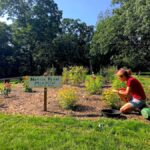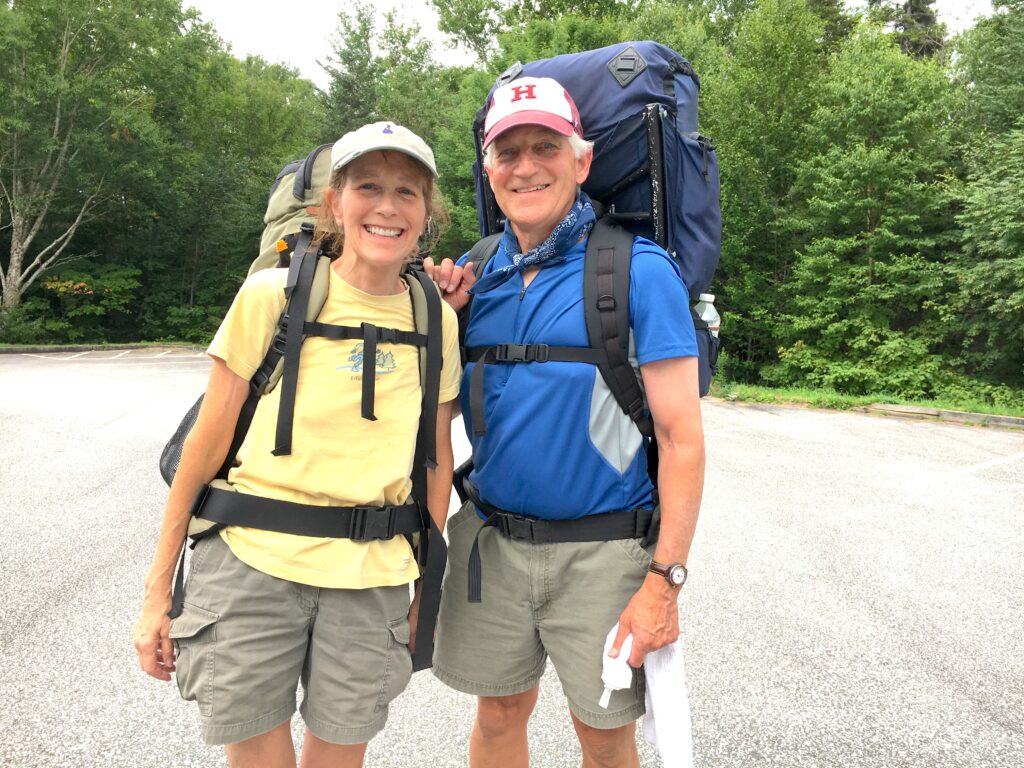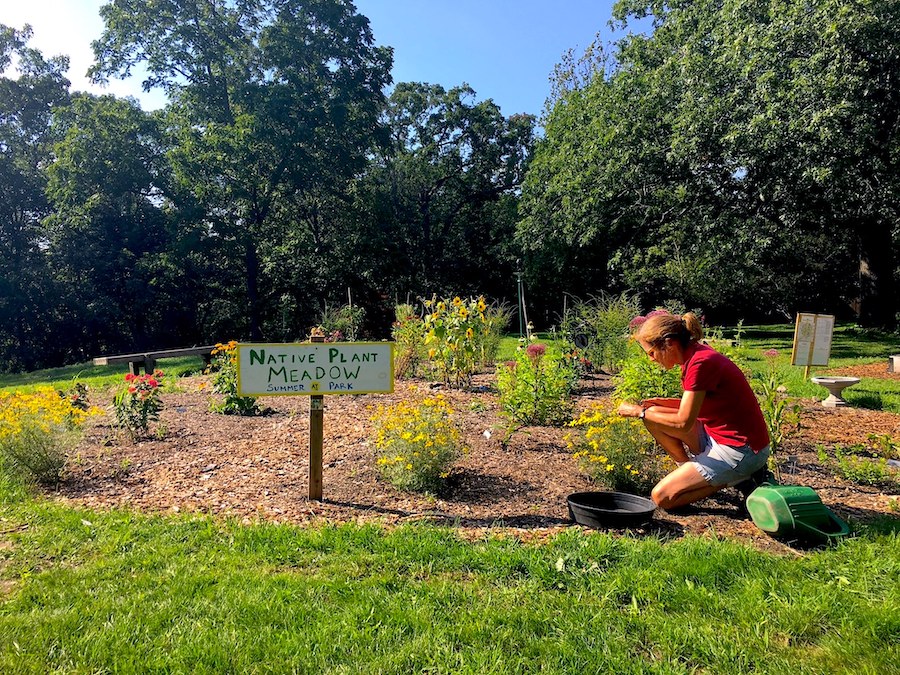
By Elissa Ely
There were woods behind Jean Devine’s house growing up in Manchester, New Hampshire. As a child, she liked pressing leaves and hated wearing socks; her mother would send her outside on ‘safaris’ with apple slices, the family dog trailing behind. She was always late to school.
Jean was unafraid of bugs and fascinated by Daddy Longlegs. Woods and spiders did not turn her into the environmental educator, native-plant coach, and landscaper she eventually became, but they were her introduction to nature. Her mother belonged to the Garden Club in an era when plots were visually beautiful, organized by color and regimented pattern, and without particular attention to native or invasive species. Back then, natural pesticide control involved plucking beetles off a rose bush and dropping them into beer (it made an impression), and concepts like biodiversity and co-speciation were decades from being discussed. But her mother encouraged an explorer’s spirit, and they tapped the sugar maple in the yard together, boiling its sap down to one tablespoon of thrilling maple syrup.
After studying European history at Brown, her road took many turns. “I’m Epicurean,” Jean explains cheerfully. “Life is a buffet.” She sampled abundantly, beginning as a community development worker in Providence, a job that ended suddenly when the Republican mayor discovered she was the daughter of a liberal Democratic judge (“case of reverse nepotism”). There followed a chapter in landscape design and another working with a high-end furniture manufacturer, where she “could feel like a designer and use colored pencils.”
Eventually, she returned to school for an MBA, thinking maybe she would find her way into real estate. Instead, she discovered the power of case studies and the pleasure of careful assessment and synthesis. This led to a decade in the biotech industry, pulling pharmaceutical science, patents, strategies, and business models together into a palatable form for an audience. Along the way, there was also time to volunteer on the board of a Concord theater group, in front of the lights and behind. “It forced me to limit endless work hours,” she says (though of course it also added more).
Most experts master a subject before turning to teaching, but Jean reversed the direction: she was driven to mentor students, then went in search of her subject. Reading widely, she became a historian of New England soil and species, evolution and ecology, childhood development, and environmental awareness. She learned how indigenous insect, avian, plant, and tree species co-evolved and continue to require one another, how the native insect can’t sustain itself on a non-native plant, and how most native plants require pollination from a native species. A garden that strikes us as visually appealing—maybe tailored, maybe flamboyant—strikes local butterflies and bees as nutritionally empty: an asphalt lot.
Recognizing a problem does not lead reliably to recognizing a solution. But Jean realized what many of us haven’t yet: that we can’t depend on national parks and federal organizations for salvation. We are our own best hope, in our own backyards. “It’s the urgency of now,” she says.
Endangered monarchs and honeybees are “the poster children for the movement” but also the tip of all the species in decline. For those who doubt, she recommends the Windshield Test: speeding down the Mass Pike at 65 mph, where has the usual coating of insects gone?
In 2014, she co-founded an education and environmental program for campers, high school and college students in Arlington, Belmont, Cambridge, and Waltham. She describes it as “place-based and project-based learning.” Students are paid to design and market native-plant-based gardens, to remediate lacking habitats, to prune out invasives. “Can you teach curiosity?” she asks and answers herself. “I always thought you could. They see how excited I am.”
They learn ecology, landscape design, marketing, financing, and customer relations; a universe from a grain of soil. So far, 50 plots have been planted or revised. For the Builders, it’s education and profit. For the gardens (including in front of Payson Park Church), it’s a living laboratory. For the cause of local biodiversity, it’s hope.
In 2020, Jean cofounded the Mystic Charles Pollinator Pathways Project, another byproduct of the urgency of now. Adapting one yard at a time may be insufficient to support declining native bees, butterflies, moths, wasps, and birds. For one thing, they are dietary specialists; monarchs eat milkweed, and caterpillars won’t dine on trees from China or Japan. For another, pollinators can’t fly far; native bees have a range of only 750 meters. Adequate public and private pollinator sites need to be closely spaced.
Through its volunteers, the Project created a point-to-point map of gardens that contain the necessary native plantings. The map identifies nutritional corridors that already exist, but also, geographical gaps in need of revision. It’s a local response to species loss, as well as an antidote to the helplessness of the individual. And, it’s a dynamic undertaking under constant re-assessment, thanks to those who track their own data (does your garden have six native species?) and update surveys. (You can add your garden to the map at bit.ly/BCF-Pollinator-Map—Editor)
Most recently, Jean founded Devine Native Plantings, where she is “chief seed sower and native-plant coach,” auditing sites and yards, then tailoring them to native plants. It’s her only for-profit venture—although, as she points out, “I haven’t done the taxes yet this year.”
The forest in Manchester she used to wander through as a child is gone. A field she crossed on the way to school is covered with houses. Now she lives in Belmont, with a small lawn in front and a large garden in back. “It’s like a mullet haircut,” she says.
Here she raises sun-lovers like penstemon, swamp milkweed, golden Alexander, and Carolina rose; partial shade-lovers like wood asters and sedge, native goatsbeard, kalmia, and mountain laurel; affable sun-shade accommodators like turtlehead, yellowroot, purple coneflower, and cohosh. Reciting their names is like reciting a poem aloud. Put them to music, and you have an aria.
Long ago, in college, Jean sang in an a capella choir. She sang with others then. She wants others to sing with her now.
Elissa Ely is a community psychiatrist.




Sorry, the comment form is closed at this time.